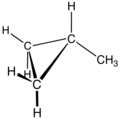Metilciclopropano Uso | Reações | Referências Menu de navegação594-11-611657CRC Handbook of Chemistry and Physicsexpandindo-o
Alcanos
CHalquil cicloalcanometanociclopropanoaminas terciáriastensão de Baeyeralquenosadição eletrofílicasubstituição eletrofílicaruptura de anelclivagem de ligaçãohalogenaçãoaminas terciárias
| Metilciclopropano Alerta sobre risco à saúde | |
|---|---|
 |  |
Nome IUPAC | methylcyclopropane |
| Identificadores | |
Número CAS | |
PubChem | |
SMILES |
|
| Propriedades | |
Fórmula molecular | C4H8 |
Massa molar | 56.11 g/mol |
| Aparência | colourless gas[1] |
Densidade | 0.6912[1] |
Ponto de fusão | −117.2 °C[1] |
Ponto de ebulição | 4–5 °C[1] |
| Compostos relacionados | |
Cicloalcanos relacionados | Ciclopropano 1,1-Dimetilciclopropano 1,2-Dimetilciclopropano Ciclobutano Metilciclobutano Metilciclopentano Espiropentano (dois ciclopropanos com um C em comum) |
| Compostos relacionados | 1-Metilciclopropeno 2-Metilaziridina e N-metilaziridina (``N`` no anel triangular) |
Exceto onde denotado, os dados referem-se a materiais sob condições normais de temperatura e pressão Referências e avisos gerais sobre esta caixa. Alerta sobre risco à saúde. | |
Metilciclopropano (C4H8) é alquil cicloalcano composto de metano e ciclopropano.
Uso |
É usado como grupo funcional em aminas terciárias.
Reações |
O metilciclopropano provê um exemplo extremo de como decresce a estabilidade de alquil cicloalcanos com o decréscimo do tamanho do anel, devido a tensão de Baeyer. Eles reagem de maneira similar aos alquenos, embora eles não reajam por meio de EA (cf. adição eletrofílica), mas com o mecanismo de reação SN2 (cf. substituição eletrofílica). Estas reações são tanto reações de ruptura de anel e clivagem de ligação externas ao anel. Dois exemplos são as reações de halogenação:
- H3C-CicProp + HBr → H3C-CHBr-CH2-CH3 (rompimento de anel)
- H3C-CicProp + HBr → H3C-H + Br-CicProp (clivagem de ligação)
A última reação é importante devido a clivagem do anel ciclopropil em aminas terciárias.
Referências
↑ abcd Lide, David. R, ed. (2009). CRC Handbook of Chemistry and Physics 89th ed. [S.l.]: CRC Press. ISBN 9781420066791